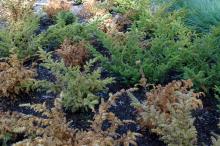See:
Cedar, Port Orford (Chamaecyparis lawsoniana) - Root Rot
APHIS List of Regulated Hosts and Plants Proven or Associated with Phytophthora ramorum
Cause Several Phytophthora spp. have been reported on various Taxus spp. The fungus-like microorganisms Phytophthora lateralis and P. cinnamomi can kill Pacific yew (Taxus brevifolia) seedlings and trees. Dead trees can be found along streams and in saturated soils in forested areas of southern Oregon. Although found in the same areas as heavily infected Port Orford cedars, soil saturation was a more important factor. Pacific yew is much less susceptible than Port Orford cedar to P. lateralis. Root rot has also been a common problem in samples sent to the OSU Plant Clinic from container nursery production. Phytophthora ramorum has also been found on and associated with various Taxus spp.
These fungus-like microorganisms survive as oospores or chlamydospores in plant debris such as rotted roots or foliage. Spores may be moved long distances in contaminated soil through human activities (for example, by logging equipment), by cattle, or through moving water. Spores germinate and produce sporangia and a swimming spore stage called zoospores, which attack fine roots and begin to rot the root system. Tree-to-tree spread can occur through root grafts.
Symptoms The organism infects small roots first, then larger and larger roots until the tree is girdled near the collar. The fine roots are at first water soaked, then darken and quickly disintegrate. Infected inner bark turns cinnamon-brown in contrast to the normal cream color of healthy tissue. There generally is a sharp line between infected and healthy tissues. Infected trees' foliage is a slightly lighter color and may wilt on warm days. All foliage soon turns chlorotic, then bronze, and finally brown. Seedlings may die a few weeks after infection; large trees may take 2 to 4 years to die.
Cultural control
- Plant healthy seedlings in soil known to be free of these organisms.
- Do not plant in soil with poor drainage or in areas that receive drainage from roads.
- Prevent wounding at the base of trees or to roots from nearby construction or harvesting operations.
- Promptly remove and destroy dead and dying trees to help protect other trees in the area. Avoid moving infested soil while removing trees and/or stumps.
- In sensitive forested areas of southwest Oregon, unpaved roads are closed during the rainy season. Also, consider removal of cedars along the road side to prevent infections in those areas.
- Avoid reusing pots from a previous crop for propagation. If pots must be reused then wash off all debris and soak in a sanitizing solution or treat with aerated steam for 30 min.
Chemical control These chemicals may help prevent infection or allow slightly infected trees to survive the disease given annual spring and/or fall applications. Severely infected trees will not benefit and will die. Rotate fungicides from different FRAC groups that have a different mode of action for resistance management.
- Aliette at 2.5 to 5 lb/100 gal water as a foliar spray to nursery plants. Do not reapply within 30 days. Do not use with adjuvants. Group P7 fungicide. 24-hr reentry.
- ArborFos (from Mauget) can be injected into trees at a rate of 5 ml/inch diameter at breast height. See label for details. Unknown efficacy in the Pacific Northwest.
- Banrot 40 WP at 6 to 12 oz/100 gal water for container- or bed-grown plants. Group 1 + 14 fungicide. 12-hr reentry.
- Fosphite at 1 to 2 quarts/100 gal water. Do not use copper products within 20 days of treatment and do not use spray adjuvants. Group P7 fungicide. 4-hr reentry.
- Mefenoxam 2 AQ at 0.98 to 1.96 oz/100 gal water as a soil drench or at 1.23 to 2.45 oz/1,000 sq ft followed by at least 0.5 inch rain or irrigation. Group 4 fungicide. No restrictions on reentry when used as a soil drench or media incorporation.
- Monterey Garden Phos at 16 fl oz in 16 fl oz water plus 1 oz Pentra-Bark as a basal trunk spray. Also labeled for injection, see label for details. Can be used in landscape sites. Group P7 fungicide. H
- Phospho-Jet at 1 to 2 quarts/100 gal water as a soil drench. Group P7 fungicide. 4-hr reentry.
- Phostrol at 51 fl oz/74 fl oz water plus an organosilicone surfactant used as a basal bark spray. Also labeled for injection, see label for details. Group P7 fungicide. 4-hr reentry.
- Subdue MAXX as a soil surface spray at 1.25 to 2.5 fl oz/1000 sq ft; irrigate with 0.5 inch water within 24 hours of application. Group 4 fungicide. 48-hr reentry.
- Terrazole 35 WP at 3.5 to 10 oz/100 gal water as a soil drench. Use only in commercial nurseries and greenhouses. Group 14 fungicide.12-hr reentry.
References Beal, E. J., Waghorn, I. A., Perry, J. N., Clover, G. R. and Cromey, M. G. 2021. Susceptibility of Garden Plants to Phytophthora Root Rot. Plant Disease, 105:1610-1620.
Murray, M. S. 1995. Susceptibility of Pacific yew (Taxus brevifolia Nutt.) to Phytophthora lateralis. MS thesis, Oregon State University. pp 98.



